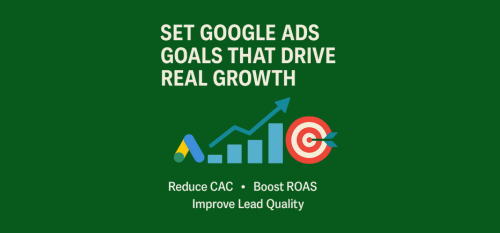By Clark Mago
When your marketing budget is on the line, the last thing you want is to play it safe. Setting bold, data-driven Google Ads performance goals isn’t just a best practice, it’s a competitive advantage. If you’re tired of campaigns that generate clicks but lack clarity on ROI, it’s time to take a more strategic, performance-focused approach.
Why Generic Google Ads Goals Fall Short
Many businesses default to broad goals like “increase traffic” or “get more leads.” But without precision and measurable benchmarks, these goals don’t move the needle. For growth-focused brands competing in crowded B2C markets, that simply won’t cut it.
Instead, your Google Ads performance goals need to be tightly aligned with business outcomes, like lowering customer acquisition cost (CAC), improving return on ad spend (ROAS), and generating higher-quality leads. When done right, these goals create a roadmap for scaling your campaigns with confidence.
Step 1: Benchmark First, Then Aim Higher
Start by reviewing your current data. Look at metrics like:
- Cost-per-click (CPC)
- Conversion rate
- Cost per conversion
- Lead quality (based on CRM feedback or sales team input)
Compare these to your industry benchmarks but don’t settle for average. Your Google Ads performance goals should push beyond what competitors are doing. That’s how you capture market share, not just maintain it.
Step 2: Define Smart, Measurable Goals
Set specific, measurable goals tied to outcomes, such as:
- Reduce cost-per-conversion by 20% over the next 60 days
- Increase conversions from high-intent search terms by 30%
- Boost ROAS by 1.5x for retargeting campaigns
- Raise qualified lead volume by 25% quarter over quarter
By using performance-focused KPIs, you’ll not only improve efficiency but also gain insight into where your budget works hardest.
Step 3: Align Goals With Funnel Stage & Campaign Type
Not all campaigns serve the same purpose. Brand awareness, lead generation, and remarketing all require different benchmarks. Tailor your Google Ads performance goals based on the campaign type:
- For top-of-funnel: Optimize for impressions and CTR
- For mid-funnel: Focus on landing page conversion rate
- For bottom-of-funnel: Track lead quality, sales conversion, and CAC
This alignment ensures every campaign is held to the right standard and contributes meaningfully to business growth.
Step 4: Automate Reporting & Attribution
Clear performance goals are only powerful if you can measure them. Set up automated dashboards that track your KPIs in real time. Integrate Google Ads with your CRM and analytics platforms so you can attribute leads and revenue back to specific campaigns or keywords. This will help you identify what’s working and scale it faster.
Step 5: Work With a Strategic Google Ads Partner
If your internal team lacks the time or expertise to consistently optimize, it’s time to bring in a partner. The right agency doesn’t just manage campaigns—they act like an extension of your team, offering strategic guidance, transparent reporting, and ROI-driven insights.
Ready to Set Smarter Google Ads Performance Goals?
DoubleDome Digital Marketing helps B2C businesses set, track, and achieve Google Ads performance goals that drive real growth. From automated reporting dashboards to custom lead-gen strategies, we build campaigns that outperform benchmarks—and your competition.
Let’s talk about your Google Ads goals and create a performance strategy that delivers results.









